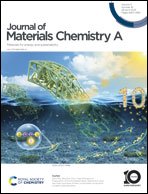Rational strategy to enhance the thermal stability of solar cell performance using a photocrosslinkable conjugated polymer†
Abstract
In addition to the power conversion efficiency (PCE) of polymer solar cells (PSCs), long-term stability is a critical requirement. In this study, a crosslinkable PM6-based polymer donor, PM6-X30, was developed by introducing photocrosslinkable side chains into the PM6 polymer backbone. The new PM6-X30 retained the fundamental properties of the high-performance PM6 backbone. The crosslinking reaction was induced under the mild condition of UV 365 nm irradiation for 10 min, forming a stable polymer network to lock the internal morphology of the active layer. The PSC fabricated with the crosslinked PM6-X30:Y6-BO active layer exhibited a high PCE of 12.33%. Subsequently, this device sustained more than 80% of its original PCE after thermal aging at 80 °C for 180 min, while the non-crosslinked device and the reference device based on PM6-X0 could only retain 27.7 and 42.9% of their PCE, respectively, under the same aging conditions. This work demonstrates a promising strategy for boosting the long-term stability of high-performance PSCs, even at a slight sacrifice of the maximum PCE.



 Please wait while we load your content...
Please wait while we load your content...